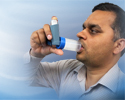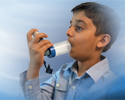How to use an inhaler - with spacer
Metered-dose inhaler (MDI) administration - with spacer; Asthma - inhaler with spacer; Reactive airway disease - inhaler with spacer; Bronchial asthma - inhaler with spacerMetered-dose inhalers (MDIs) usually have 3 parts:
- A mouthpiece
- A cap that goes over the mouthpiece
- A canister full of medicine
If you use your inhaler the wrong way, less medicine gets to your lungs. A spacer device may help. The spacer connects to the mouthpiece. The inhaled medicine goes into the spacer tube first. Then you take two deep breaths to get the medicine into your lungs. Using a spacer wastes a lot less medicine than spraying the medicine into your mouth.
Spacers come in different shapes and sizes. Ask your provider which spacer is best for you or your child. Almost all children can use a spacer. You do not need a spacer for dry powder inhalers.
The steps below tell you how to take your medicine with a spacer.
Getting Ready
- If you have not used the inhaler in a while, you may need to prime it. See the instructions that came with your inhaler for how to do this.
- Take the cap off the inhaler and spacer.
- Shake the inhaler hard 10 to 15 times before each use.
- Attach the spacer to the inhaler.
- Breathe out gently to empty your lungs. Try to push out as much air as you can.
Breathe in Slowly
- Put the spacer between your teeth and close your lips tightly around it.
- Keep your chin up.
- Start breathing in slowly through your mouth.
- Spray one puff into the spacer by pressing down on the inhaler.
- Keep breathing in slowly. Breathe as deeply as you can.
Hold Your Breath
- Take the spacer out of your mouth.
- Hold your breath as you count to 10, if you can. This lets the medicine reach deep into your lungs.
- Pucker your lips and slowly breathe out through your mouth.
- If you are using inhaled, quick-relief medicine (beta-agonists), wait about 1 to 2 minutes before you take your next puff. You do not need to wait between puffs for other medicines.
Quick-relief medicine
Asthma quick-relief medicines work fast to control asthma symptoms. You take them when you are coughing, wheezing, having trouble breathing, or havi...
Read Article Now Book Mark Article - Put the caps back on the inhaler and spacer.
- After using your inhaler, rinse your mouth with water, gargle, and spit. Do not swallow the water. This helps reduce side effects from your medicine.
Keep Your Inhaler Clean
Look at the hole where the medicine sprays out of your inhaler. If you see powder in or around the hole, clean your inhaler. First, remove the metal canister from the L-shaped plastic mouthpiece. Rinse only the mouthpiece and cap in warm water. Let them air-dry overnight. In the morning, put the canister back inside. Put the cap on. Do not rinse any other parts.
Replacing Your Inhaler
Most inhalers come with counters on the canister. Keep an eye on the counter and replace the inhaler before you run out of medicine.
Do not put your canister in water to see if it is empty. This does not work.
Bring your inhaler to your clinic appointments. Your health care provider can make sure you are using it the right way.
Storing Your Inhaler
Store your inhaler at room temperature. It may not work well if it is too cold. The medicine in the canister is under pressure. So make sure not to get it too hot or puncture it.
References
Laube BL, Dolovich MB. Aerosols and aerosol drug delivery systems. In: Burks AW, Holgate ST, O'Hehir RE, et al, eds. Middleton's Allergy Principles and Practice. 9th ed. Philadelphia, PA: Elsevier; 2020:chap 63.
Waller DG. Asthma and chronic obstructive pulmonary disease. In: Waller DG, ed. Medical Pharmacology and Therapeutics. 6th ed. Philadelphia, PA: Elsevier; 2022:chap 12.
Review Date: 2/3/2024
Reviewed By: Frank D. Brodkey, MD, FCCM, Associate Professor, Section of Pulmonary and Critical Care Medicine, University of Wisconsin School of Medicine and Public Health, Madison, WI. Also reviewed by David C. Dugdale, MD, Medical Director, Brenda Conaway, Editorial Director, and the A.D.A.M. Editorial team.




